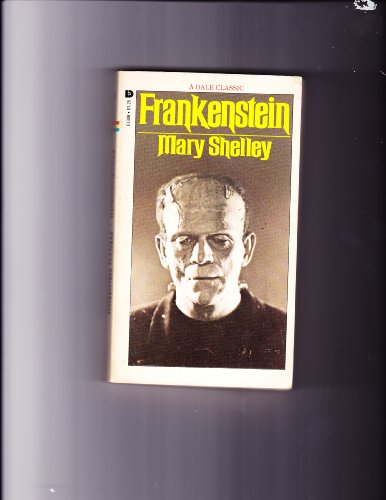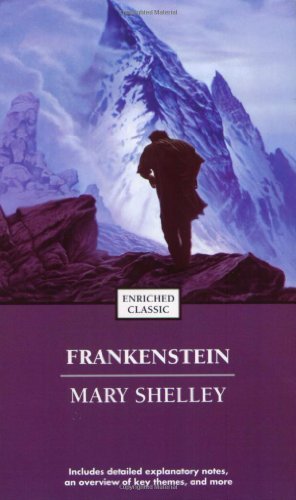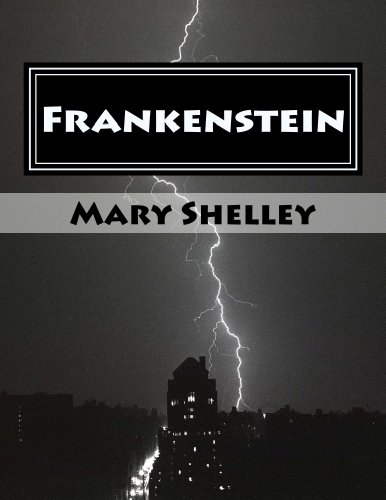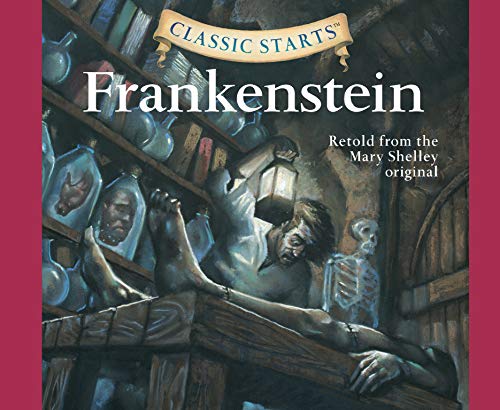-
Frankenstein
Mary Wollstonecraft Shelley
Paperback (Wordsworth Editions Ltd, Sept. 1, 1997)With an Introduction and Notes by Dr Siv Jansson, University of Greenwich Begun when the author was only eighteen and conceived from a nightmare, Frankenstein, is the deeply disturbing story of a monstrous creation which has terrified and chilled readers since its first publication in 1818. The novel has thus seared its way into the popular imagination while establishing itself as one of the pioneering works of modern science fiction.
-
Frankenstein
Mary Shelley, PlanetMonk Books
eBook (PlanetMonk Books, Dec. 28, 2013)This is the original text of Frankenstein as published in 1818. A much tighter, swifter text than the heavily revised 1831 edition, edited by Shelley, in part, to make the story more conservative.We monks poo-poo conservatism.This edition includes the essay "Mother Frankenstein" by Brother Jonathan, O. S. B.
-
Frankenstein
Mary Shelley
Mass Market Paperback (Dale Books, Sept. 3, 1978)paperback, unusual cover
-
Frankenstein
Mary Shelley
Mass Market Paperback (Simon & Schuster, Sept. 3, 1742)None
-
Frankenstein; or, The Modern Prometheus:
Mary Wollstonecraft Shelley
Paperback (Benediction Classics, Sept. 24, 2016)Mary Shelley’s Frankenstein is the world’s most famous Gothic novel and the first work of science fiction, with Frankenstein’s monster being a symbol of science gone awry. Shelley’s masterpiece has inspired numerous films, plays and other books. This, the 1831 edition, contains the author’s final revisions.
-
Frankenstein - Levels of Understanding
Mary Shelley
Spiral-bound (Prestwick House, Inc., Jan. 1, 2011)Use Bloom's Taxonomy to Help Students Independently Evaluate LiteratureInstead of teaching your students how to answer questions about a particular text, help them develop the skills to critically evaluate literature without relying on outside guidance. Using Bloom's learning domains, Levels of Understanding breaks down complex questions into smaller parts and outline the steps necessary for students to develop a sound evaluation of a text. Students will begin with the most basic and fundamental skill, comprehension, move on to reader response, analysis, and synthesis, and gradually build to the highest skill, evaluation. Not only will these guides help you prepare your students for standardized tests like the AP* Language and Literature exam, the SATs,* and the ACTs, but they will also give students the self-assurance to develop and articulate a personal assessment of the text - a skill that will be advantageous in college and beyond.*Note from Publisher: SAT and AP are registered trademarks of the College Entrance Examination Board, which was not involved in the production of and does not endorse this product.
-
Frankenstein
Mary Shelley, Alpine Books
language (Alpine Books, Feb. 25, 2014)•This e-book publication is unique which includes detailed Biography. •This edition also includes Historical Work. •A new table of contents has been included by a publisher. •This edition has been corrected for spelling and grammatical errors.Mary Shelley’s Frankenstein is a classic tale of a man-made monster seeking acceptance from society in light of his ghastly appearance and strange upbringing. With Europe as its back in the 1790’s, the story begins with a series of letters exchanged between Captain Robert Walton and his sister that chronicled the story of a man, Victor Frankenstein, whom he meets on the North Pole.Frankenstein, loved by many decades of readers and praised by such eminent literary critics, seems hardly to need a recommendation. If you haven't read it recently, though, you may not remember the sweeping force of the prose, the grotesque, surreal imagery, and the multilayered doppelgänger themes of Mary Shelley's masterpiece. Plot:After being rescued from near death, Victor Frankenstein tells Robert Walton the story of his upbringing in a warm Swiss family and his fascination with studying how life was formed. He was an avid, amateur scientist who created a "perfect" human from spare body parts - only to have his plan backfire when the monster turned out to be extremely hideous and unappealing. During a brief study and recovery period with Henry Clerval, his closest friend, Frankenstein’s monster navigated the social scene for human friendship and was turned down again and again. After observing a family living in a small cottage, monster Frankenstein mustered the courage to seek an invite before getting rejected again. The last straw, he ventured out to seek revenge on the person who created him.During his trip back to Geneva, Switzerland - the monster met Frankenstein’s younger brother and killed him for revenge. After his brother’s death, Frankenstein went back to Geneva and found the monster canvassing the same woods his brother was last seen, coming to the realization the monster was responsible for this brutal act. After a short trip to the mountains, the monster caught up to Frankenstein and ordered him to create a female monster from scratch for companionship. After agreeing, he fled to England to start and scrapped the project midway, citing the possibility of further disarray. Knowing his days were numbered after Henry Clerval’s murder, he hastily married his cousin Elizabeth only to find his new wife killed by the monster later.After paying a visit to the cemetery to meet with his fallen family members, Victor realizes that his life’s goal from that point forward was to hunt down the monster and kill him. Prior, Victor already determines his fate and goes ahead with his wedding day, knowing the monster would catch up to him. Now, he sought to kill the monster to save humanity from his menace. Victor chases after him throughout Europe and the North Pole, where he temporarily loses track of the monster through a crack in the ice where he also meets Robert Walton and his crew. Ambitious, Victor gives a thorough lecture on how chasing glory was his Achilles heel and the dangerous of being too ambitious, citing "tranquility" as one of life’s Goa.
-
Frankenstein
Mary Shelley
language (UMash Marketing Ltd, Dec. 16, 2013)•This e-book publication is unique which includes exclusive Introduction, Historical Background and handcrafted additional content. •This edition also includes detailed Biography, Notes, Criticisms and Interpretations. •A new table of contents with working links has been included by a publisher. •This edition has been corrected for spelling and grammatical errors.
-
Frankenstein
Mary Shelley, Deanna McFadden, Rebecca K. Reynolds
Audio CD (Oasis Audio, March 10, 2020)Following Sterling's spectacularly successful launch of its children's classic novels (240,000 books in print to date),comes a dazzling new series: Classic Starts. The stories are unabridged and have been rewritten for younger audiences. Classic Starts treats the world's beloved tales (and children) with the respect they deserve. Mary Shelley’s tragic story of a scientist who created a monster is perhaps even more compelling and meaningful today than when it was written nearly two centuries ago. From the bits and pieces of dead bodies, and the power of electricity, the brilliant Victor Frankenstein fashions a new form of life—only to discover, too late, the irreparable damage he has caused. Z+
Z+
-
FRANKENSTEIN
Mary Shelley
eBook (Musaicum Books, Dec. 6, 2017)Frankenstein; or, The Modern Prometheus is a novel written by Mary Shelley about a creature produced by an unorthodox scientific experiment. Shelley started writing the story when she was nineteen, and the novel was published when she was twenty-one. The first edition was published anonymously in London in 1818. Shelley's name appears on the second edition, published in France in 1823. The original 1818 'Uncensored' Edition of Frankenstein as first published anonymously in 1818. This original version is much more true to the spirit of the author's original intentions than the heavily revised 1831 edition, edited by Shelley, in part, because of pressure to make the story more conservative. Many scholars prefer the 1818 text to the more common 1831 edition.Mary Wollstonecraft Shelley (1797–1851) was an English novelist, short story writer, dramatist, essayist, biographer, and travel writer, best known for her Gothic novel Frankenstein: or, The Modern Prometheus.
-
Frankenstein
Fiona Macdonald, Mary Shelley, Penko Gelev
Paperback (Scribo, Sept. 5, 2017)Mary Shelley’s compelling story of a scientist horrified by his own creation—and the monster’s revenge—is now vividly illustrated and faithfully retold in graphic-novel form! Stunned by his mother’s tragic death, Victor Frankenstein becomes obsessed with discovering the deepest mysteries of creation—and the secret of bringing dead matter to life. Gathering materials from graveyards and slaughterhouses, he successfully fashions a giant of superhuman strength. But, horrified at the monster he has brought into existence, he flees, leaving it to fend for itself. How will the creature react to being abandoned by its creator? Mary Shelley's groundbreaking horror story will captivate readers in this spectacular graphic-novel retelling. In addition to the novel, this edition includes a biography of Mary Shelley, scientific discoveries at the time the original novel was written, a listing of Frankenstein movies, and footnotes to explain difficult words and ideas. Z+
Z+
-
Frankenstein
Mary Wollstonecraft Shelley, Rachel Lay
eBook (, Aug. 10, 2014)• The book includes 10 unique illustrations that are relevant to its content.Frankenstein; or, The Modern Prometheus is a novel written by Mary Shelley about a monster produced by an unorthodox scientific experiment. Shelley started writing the story when she was eighteen, and the novel was published when she was twenty-one. The first edition was published anonymously in London in 1818. Shelley's name appears on the second edition, published in France in 1823. Shelley had travelled the region in which the story takes place, and the topics of galvanism and other similar occult ideas were themes of conversation among her companions, particularly her future husband, Percy. The storyline emerged from a dream. Mary, Percy, Lord Byron, and John Polidori decided to have a competition to see who could write the best horror story. After thinking for weeks about what her possible storyline could be, Shelley dreamt about a scientist who created life and was horrified by what he had made. She then wrote Frankenstein. Frankenstein is infused with some elements of the Gothic novel and the Romantic movement and is also considered to be one of the earliest examples of science fiction. Brian Aldiss has argued that it should be considered the first true science fiction story, because unlike in previous stories with fantastical elements resembling those of later science fiction, the central character "makes a deliberate decision" and "turns to modern experiments in the laboratory" to achieve fantastic results. The story is partially based on Giovanni Aldini's electrical experiments on dead and (sometimes) living animals and was also a warning against the expansion of modern humans in the Industrial Revolution, alluded to in its subtitle, The Modern Prometheus. It has had a considerable influence across literature and popular culture and spawned a complete genre of horror stories and films. Since publication of the novel, the name "Frankenstein" is often used to refer to the monster itself, as is done in the stage adaptation by Peggy Webling. This usage is sometimes considered erroneous, but usage commentators regard the monster sense of "Frankenstein" as well-established and not an error. In the novel, the monster is identified via words such as "creature," "monster", "fiend", "wretch", "vile insect", "daemon", and "it". The monster refers to himself speaking to Dr. Frankenstein as "the Adam of your labors", and elsewhere as someone who "would have" been "your Adam", but is instead your "fallen angel".